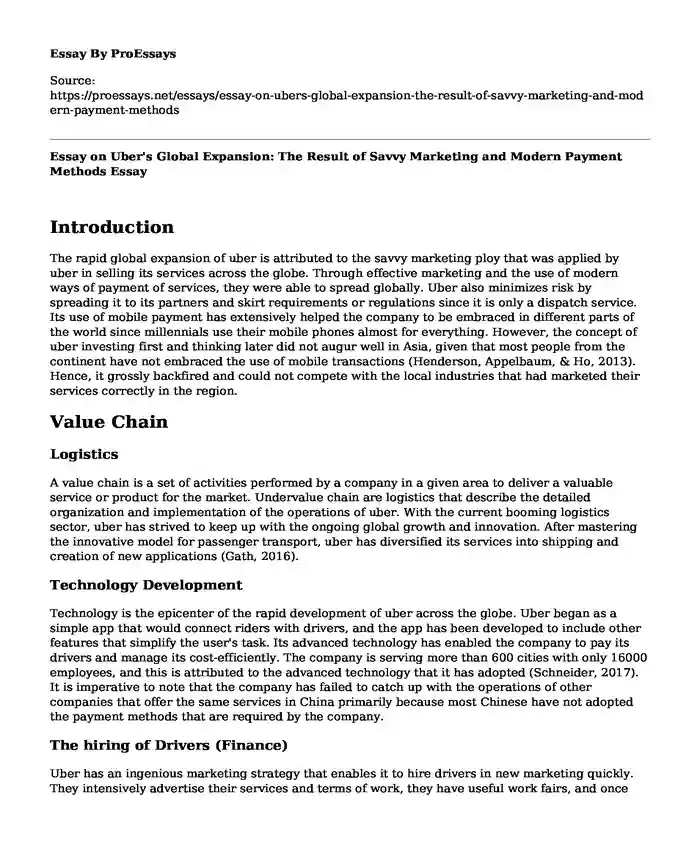Introduction
The rapid global expansion of uber is attributed to the savvy marketing ploy that was applied by uber in selling its services across the globe. Through effective marketing and the use of modern ways of payment of services, they were able to spread globally. Uber also minimizes risk by spreading it to its partners and skirt requirements or regulations since it is only a dispatch service. Its use of mobile payment has extensively helped the company to be embraced in different parts of the world since millennials use their mobile phones almost for everything. However, the concept of uber investing first and thinking later did not augur well in Asia, given that most people from the continent have not embraced the use of mobile transactions (Henderson, Appelbaum, & Ho, 2013). Hence, it grossly backfired and could not compete with the local industries that had marketed their services correctly in the region.
Value Chain
Logistics
A value chain is a set of activities performed by a company in a given area to deliver a valuable service or product for the market. Undervalue chain are logistics that describe the detailed organization and implementation of the operations of uber. With the current booming logistics sector, uber has strived to keep up with the ongoing global growth and innovation. After mastering the innovative model for passenger transport, uber has diversified its services into shipping and creation of new applications (Gath, 2016).
Technology Development
Technology is the epicenter of the rapid development of uber across the globe. Uber began as a simple app that would connect riders with drivers, and the app has been developed to include other features that simplify the user's task. Its advanced technology has enabled the company to pay its drivers and manage its cost-efficiently. The company is serving more than 600 cities with only 16000 employees, and this is attributed to the advanced technology that it has adopted (Schneider, 2017). It is imperative to note that the company has failed to catch up with the operations of other companies that offer the same services in China primarily because most Chinese have not adopted the payment methods that are required by the company.
The hiring of Drivers (Finance)
Uber has an ingenious marketing strategy that enables it to hire drivers in new marketing quickly. They intensively advertise their services and terms of work, they have useful work fairs, and once they have hired few drivers, they pay them to recruit more drivers. They flood the market with mechanisms of getting new drivers and luring potential customers. The company managed to hire drivers in China. Still, the primary impediment to the faster growth of the company in the country was the mode of payment that made other competitive companies to overtake it.
Marketing and Distribution
Technology cannot be singly identified as the primary reason for the rapid development of uber across the globe. The company also carried rigorous marketing of its services across the continents. However, some people have also claimed that the company has employed aggressive marketing strategies in some markets. The company uses different digital channels, such as social media, to promote its brand. Its user network has also played an integral role in the massive growth and spread of the company across the globe (French, 2017). It also has a rating system which acts as an effective marketing strategy.
Global Strategy + Failure in China (USA and China)
Uber is one of the fastest-growing startups in Silicon Valley. Its startup in the USA was successful, but it has failed in China due to different cultural, political, and economic environments. The company's startups must change for the Asian markets because of the diverse culture of the continent (Cuervo-Cazurra, Mudambi, Pedersen, & Piscitello, 2017). Additionally, the Chinese market has competitors who understand it better than foreign investors. Uber must localize in China, especially o technology and payment method.v
References
Cuervo-Cazurra, A., Mudambi, R., Pedersen, T., & Piscitello, L. (2017). Research methodology in global strategy research. Global Strategy Journal, 7(3), 233-240. doi:10.1002/gsj.1164
French, J. (2017). undefined. Oxford Medicine Online. doi:10.1093/med/9780198717690.003.0002
Gath, M. (2016). undefined. Optimizing Transport Logistics Processes with Multiagent Planning and Control, 15-34. doi:10.1007/978-3-658-14003-8_2
Henderson, J., Appelbaum, R. P., & Ho, S. Y. (2013). Globalization with Chinese characteristics: Externalization, dynamics, and transformations. Development and Change, 44(6), 1221-1253. doi:10.1111/dech.12066
Schneider, H. (2017). Uber: Innovation in society. Springer.
Cite this page
Essay on Uber's Global Expansion: The Result of Savvy Marketing and Modern Payment Methods. (2023, May 03). Retrieved from https://proessays.net/essays/essay-on-ubers-global-expansion-the-result-of-savvy-marketing-and-modern-payment-methods
If you are the original author of this essay and no longer wish to have it published on the ProEssays website, please click below to request its removal:
- Research Paper on Effective Strategies for Inclusive Leadership
- Essay Example on Sales and Marketing Ethics
- 4 Ps of Marketing: Pricing & Promotion Strategies for Businesses - Research Paper
- Essay Sample on Pricing Strategy for Project 28: Key to Growth Success
- Uber: Rise and Fall of a Disgraced Giant - Essay Sample
- Proposing Action to Enhance Career Planning & Retain Talented Employees - Essay Sample
- Coffee Demand Soars: Supply Chain Management Innovates to Compete - Free Paper







